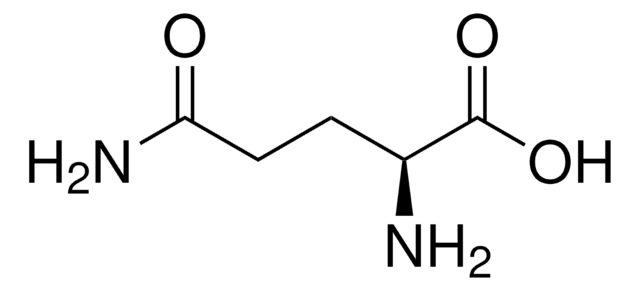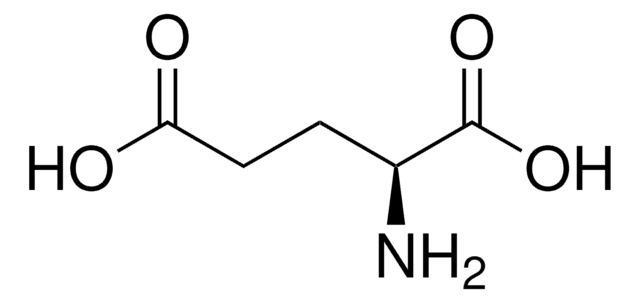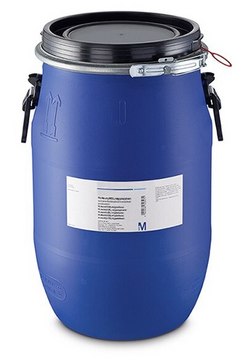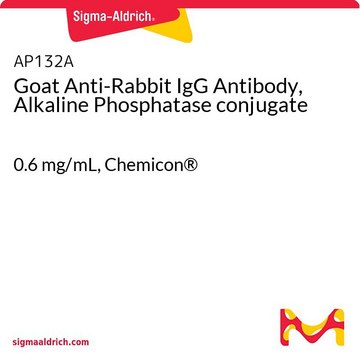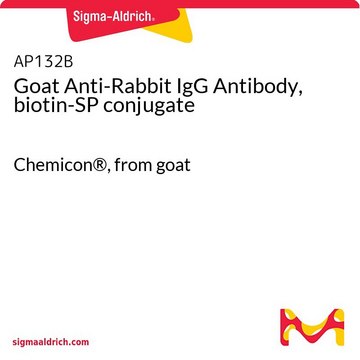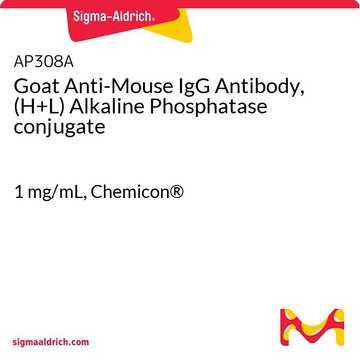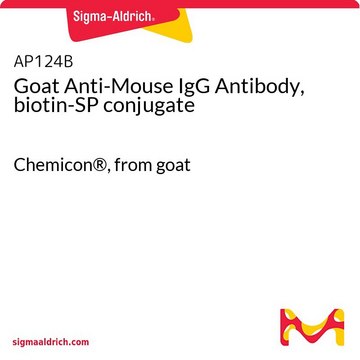W368401
L-Glutamine
Synonym(s):
(S)-2,5-Diamino-5-oxopentanoic acid, L-Glutamic acid 5-amide, Levoglutamide
Select a Size
Select a Size
About This Item
Recommended Products
biological source
synthetic
optical activity
[α]/D 29 to 33°, c = 2% in 1 M HCl
mp
185 °C (dec.) (lit.)
solubility
H2O: very soluble 14.6 g/L (completely)
application(s)
flavors and fragrances
Documentation
see Safety & Documentation for available documents
food allergen
no known allergens
Organoleptic
milk
SMILES string
N[C@@H](CCC(N)=O)C(O)=O
InChI
1S/C5H10N2O3/c6-3(5(9)10)1-2-4(7)8/h3H,1-2,6H2,(H2,7,8)(H,9,10)/t3-/m0/s1
Looking for similar products? Visit Product Comparison Guide
Related Categories
1 of 4
This Item | AP132B | AP308A | AP124B |
|---|---|---|---|
| species reactivity rabbit | species reactivity rabbit | species reactivity mouse | species reactivity mouse |
| technique(s) ELISA: suitable, western blot: suitable | technique(s) ELISA: suitable, western blot: suitable | technique(s) ELISA: suitable, western blot: suitable | technique(s) ELISA: suitable, western blot: suitable |
| biological source goat | biological source goat | biological source goat | biological source goat |
| conjugate alkaline phosphatase conjugate | conjugate biotin conjugate | conjugate alkaline phosphatase conjugate | conjugate biotin conjugate |
| clone polyclonal | clone polyclonal | clone polyclonal | clone polyclonal |
Biochem/physiol Actions
Disclaimer
Storage Class Code
11 - Combustible Solids
WGK
WGK 1
Flash Point(F)
Not applicable
Flash Point(C)
Not applicable
Choose from one of the most recent versions:
Already Own This Product?
Find documentation for the products that you have recently purchased in the Document Library.
Which document(s) contains shelf-life or expiration date information for a given product?
If available for a given product, the recommended re-test date or the expiration date can be found on the Certificate of Analysis.
How do I get lot-specific information or a Certificate of Analysis?
The lot specific COA document can be found by entering the lot number above under the "Documents" section.
How do I find price and availability?
There are several ways to find pricing and availability for our products. Once you log onto our website, you will find the price and availability displayed on the product detail page. You can contact any of our Customer Sales and Service offices to receive a quote. USA customers: 1-800-325-3010 or view local office numbers.
What is the Department of Transportation shipping information for this product?
Transportation information can be found in Section 14 of the product's (M)SDS.To access the shipping information for this material, use the link on the product detail page for the product.
Is the molecular weight of L-Glutamine 146.14 or 146.15? The label information changed.
Based on a molecular formula of C5H10N2O3, the molecular weight to seven significant figures is 146.1456. Over the years, this value may have been reported in Sigma-Aldrich documentation or on labels as either 146.15 (by rounding up) or 146.14 (by truncation). The material itself has not changed.
My question is not addressed here, how can I contact Technical Service for assistance?
Ask a Scientist here.
Chromatograms
application for HPLCapplication for HPLCOur team of scientists has experience in all areas of research including Life Science, Material Science, Chemical Synthesis, Chromatography, Analytical and many others.
Contact Technical Service